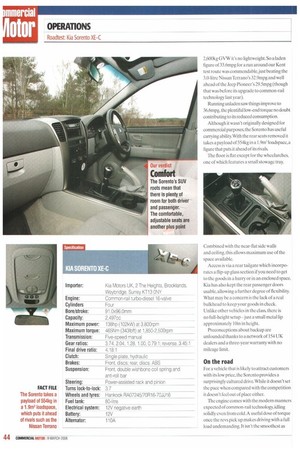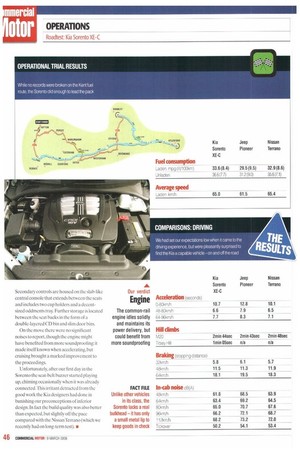THE SHAPE OF THINGS TO
Page 43

Page 44

Page 45

Page 46

If you've noticed an error in this article please click here to report it so we can fix it.
If you want to expand your product range
without too much effort, it's easy to rip out the rear seats from a car and call it a commercial
vehicle. But does Kia's newly tweaked Sorento do enough to impress?
If you go with the view that light CVs and passenger vehicles are broadly related in terms of dynamics, it follows that converting one to the other isn't going Lo be the hardest of engineering feaLs.The formula is simple: 'passenger vehicle minus rear seals plus load space equals commercial vehicle'.
But this does not necessarily guarantee that the conversion will be a success:the original set-up might have been a lemon in the first place, so calling it a van won't disguise its deficiencies. And to gain attention it helps to have a selling point, such as off-road ability.
Kia has applied this formula to its Sorento, a 4x4 SIN that has already done well in the UK sales charts. Its the first light CV to be launched by the Korean company since the Pride van, and Kia claims that the conversion was inspired by numerous requests from operators who wanted something a bit more utilitarian.
As with most Far Eastern vehicles, the price is a key selling point. Starting at £15,337, the XE-C includes air-con,16in alloy wheels,ABS with EBD, self-levelling suspension, electric windows, remote central locking and CD audio with an MP3 player— not a bad bit of kit.
Power comes from a 2.5-litre common-rail turbo-diesel producing 138hp at 3,800rpm and 343Nm between 1,850 and 2,500rpm. It is available with a manual or auto five-speed box.
In keeping with its rugged aspirations, the Kia is built on a ladder chassis complete with dualframe body construction for stiffness. It comes with 4x4 transmission selectable via a switch on the driver's side of the dash.
As for the competition,Nissan'sTerrano and Jeep's Pioneer come close in terms of layout; the differences are more noticeable when price comes into the equation. Nissan charges £16,492 while the Jeep is £17,720.
Productivity
We didn't have high expectations when it came to fuel consumption, even though the Sorento sports common-rail technology— at 2,600kg GVW it's no lightweight, So a laden figure of 33.6mpg for a run around our Kent test route was cominendable,just beating the 3.0-litre Nissan Terrano's 32.9mpg and well ahead of the Jeep Pioneer's 29.5mpg (though that was before its upgrade to common-rail technology last year).
Running unladen saw things improve to 36.6mpg, the plentiful low-end torque no doubt contributing to its reduced consumption.
Although it wasn't originally designed for commercial purposes, the Sorento has useful carrying ability. With the rear seats removed it takes a payload of 554kg in a 1.9m3loadspace, a figure that puts it ahead of its rivals.
The floor is flat except for the wheelarehes, one of which features a small stowage tray.
Combined with the near-flat side walls and ceiling, this allows maximum use of the space available.
Access is via a rear tailgate which incorporates a flip-up glass section if you need to get to the goods in a hurry or in an enclosed space. Kia has also kept the rear passenger doors usable, allowing a further degree of flexibility. What may be a concern is the lack of areal bulkhead to keep your goods in check. Unlike other vehicles in the class, there is no full-height setup —just a small metal lip approximately 10in in height.
Preconceptions about backup are unfounded thanks to a network of 154 UK dealers and a three-year warranty with no mileage limit.
On the road
For a vehicle that is likely to attract customers with its low price, the Sorento provides a surprisingly cultured drive, While it doesn't set the pace when compared with the competition it doesn't feel out of place either.
The engine comes with the modern manners expected of common-rail technology, idling solidly even from cold.A useful dose of torque once the revs pick up makes driving with a full load undemanding. It isn't the smoothest as the revs build up but it does maintain its dependable power delivery.
As an indication of this, when running unladen the Sorento managed to stay in fourth gear at the speed limit upTitsey Hill.The fivespeed manual shift is not ultra-slick, but it suits the easy nature of the engine and goes from gate to gate in a relaxed manner.
This laid-back approach is not carried into the corners, where it behaves uneasily, wallowing considerably as the chassis feels the affects of lateral forces. You wouldn't want to push it; but if you do,prepare for sharp oversteer— and wet weather will bring it on a lot quicker.
But as with all vehicles in this category, the Sorento performs better on its home ground, which is off-road. Many people will be attracted to this vehicle for its appearances, hut it also comes with decent 4x4 ability. Grip is there in abundance and all that torque allows it to dig in when tackling inclines One negative is the lack of decent damping; the suspension does feels clunky over more severe undulations. But that doesn't detract too much from its overall strength.
Cab comfort
• rhink cut-price Far Eastern commercial vehicle and you tend to think second-class cabin. But with its passenger roots, the Sorento offers an inviting set-up. Granted, grey is pervasive but it does come in varying shades which detracts from the dullness.There's plenty of space for both driver and passenger, so that SI.5V feeling is very much in evidence.
Comfort is backed up by decent seats that are adjustable in most directions,though some of the manual adjusters are difficult to use. What knocks it down a peg is the mediocre plastics that are bettered by some vans, but you can't have it all.
The instrument layout holds no surprises, though the right-sided indicator stalks did confuse to begin with... you'd think that most people would know that having your wipers on at full speed means you're turning right. Secondary controls are housed on the slab-like central console that extends between the seats and includes two cup holders and a decentsized oddments tray Further storage is located between the seat backs in the form of a double-layered CD bin and slim door bins, On the move there were no significant noises to report, though the engine might have benefited from more soundproofing: it made itself known when accelerating, but cruising brought a marked improvement to the proceedings.
Unfortunately, after our first day in the Sorento the seat-belt bi 177er started playing up, chiming occasionally when it was already connected. This irritant detracted from the good work the Kia designers had done in banishing our preconceptions of inferior design. In fact the build quality was also better than expected, but slightly off the pace compared with the NissanTerrano (which we recently had on long-term test). •
































































































































































































